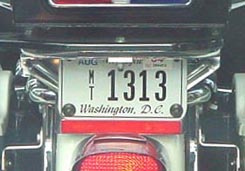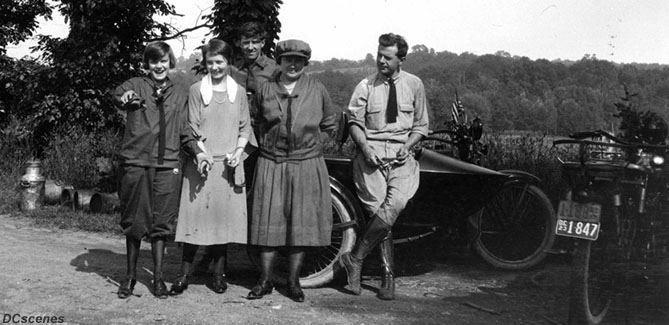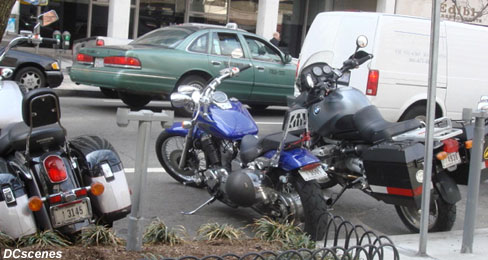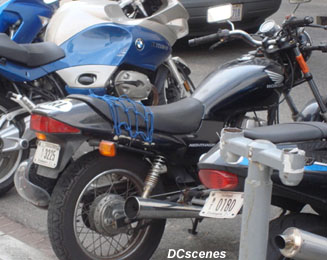Washington, D.C. Motorcycle License Plates
 Motorcycle is usually considered by license plate collectors to be the most popular non-passenger type, and the District of Columbia is clearly the most difficult U.S. jurisdiction from which to obtain a recent cycle plate. (See our statistics section for the obvious reason.) Plates of this type from the late 1960s and early 1970s are slightly more plentiful than examples of earlier and more recent plates, but in general D.C. cycle plates from all years are rare and desirable.
Motorcycle is usually considered by license plate collectors to be the most popular non-passenger type, and the District of Columbia is clearly the most difficult U.S. jurisdiction from which to obtain a recent cycle plate. (See our statistics section for the obvious reason.) Plates of this type from the late 1960s and early 1970s are slightly more plentiful than examples of earlier and more recent plates, but in general D.C. cycle plates from all years are rare and desirable.
Before 1918. It was for motorcyclists that the only distinctive non-passenger plate type was made prior to 1918, when D.C. plates were undated, considered permanent, and featured a porcelain enamel finish. There are no known examples of the earliest style, which is white on black, and just a few of the white-on-red, fender-shaped later style. Click here to reach the section of our Pre-1918 Plates page dedicated to the early history of D.C. motorcycle plates.
1918-1952. During this 35-year period motorcycle plates were issued in the same colors as passenger car and other plates. Tabs were used to revalidate multi-year plates in the same years as this was done for auto plates, meaning that the issuance and replacement of plates of both types was accomplished simultaneously from 1918 through the 1952 plate, which is marked "1952" and expired on March 31, 1953. Registration numbers were assigned sequentially, presumably beginning at 1 each year, and a letter M prefix was added in 1948 in conjunction with the adoption of system of letter prefixes to identify registrations and plates of various types.
 |
 |
|
 |
 |
 |
1946
|
||
 |
||
1952 |
||
1953, 1954, and 1955. This is when things get confusing. First, note that throughout this period registrations of all types shared a common registration year: April 1 through March 31. To summarize, we know that for 1953 cycle and full-size plates were, for the first time, marked differently, and by 1955 they were marked in the same manner. We don't know for which year, 1954 or 1955, the switch in the way cycle plates were marked was made because we don't know how 1954 cycle plates appeared.
For the 1953 registration year (April 1, 1953-March 31, 1954), although they share a green-on-white color scheme, the motorcycle plate is, like earlier plates of all types, marked with the year of issue (1953), whereas plates of all other types reverted to the system used prior to 1948 of being marked with the expiration date (3-31-54). We do not know why this inconsistency occurred.
 |
 |
1953 |
1955
|
For the 1954 registration year we simply do not yet know how motorcycle plates appeared. Owners of autos, trucks, and other vehicles received a white-on-green metal tab to renew their 1953 plates.
Based upon a common color scheme, white on green, as well as the use of a now consistent dating method, we know that by the 1955 registration year the later method of marking cycle plates had been adopted, which is to show the year of expiration (1956) just as full-size plates were marked with the full expiration date (3-31-56).
Returning to 1954, it seems most likely that the green-on-white plates used for 1953-54 were renewed with a tab, as were plates of other types, which leaves only the question as to whether the tabs are marked with the year of issue (as were 1948-1953 cycle plates), 54, or the expiration year 55, as were 1954 plates of other types. Alternatively, new dated plates could have been issued to motorcyclists, in which case the question remains as to how they were marked.
1955-1977. Regardless of what happened to motorcycle plates of 1954, we know that for the 1955 through 1977 registration years plates of this type were marked with the year or exact date of expiration. Specifically, the rather confusing method of using only the expiration year was used from 1955 (dated 1956) through 1972 (dated 1973), whereas the expiration date appears on 1973 (EXP-3-31-74) through 1977 (EXP-3-31-78) plates. Note that every motorcyclist owner received a new plate annually throughout this 33-year period even though plates of many other types were revalidated with stickers for multiple years beginning in 1966. Motorcycle registration numbers of this period, which include an M prefix, were assigned sequentially beginning at M-1 annually.
 |
 |
1955 exp. 3-31-56 |
1956 exp. 3-31-57 |
 |
 |
 |
1962 exp. 3-31-63 |
1963 exp. 3-31-64 |
1964 exp. 3-31-65 |
 |
 |
 |
1965 exp. 3-31-66 |
1967 exp. 3-31-68 |
1968 exp. 3-31-69 |
 |
 |
 |
1969 exp. 3-31-70 |
1970 exp. 3-31-71 |
1972 exp. 3-31-73 |
 |
 |
 |
1974 |
1975 |
1976
|
 |
||
1977 |
||
Since 1978. Due to the 1978 adoption of undated, multi-year baseplates, we know less about the numbering and appearance of motorcycle plates issued in the past 30 years than we do about plates issued from 1918 through 1977. Validation stickers used on motorcycle plates to indicate both the month and year of expiration have always been of the same style used on full-size plates.
1978 Baseplate. When 1977 motorcycle plates were removed from service during March 1978, issued in their place were undated, multi-year plates such as had been issued for use on passenger cars for many years. We assume that this base was issued simultaneously with the undated 1978 base used for auto and other plate types, but this has not been confirmed. Because this is a multi-year base, higher registration numbers were required than had been necessary when plates were replaced annually. Upon the assignment of number M9999 in the early 1980s, the N-prefix series was introduced.
 |
 |
 |
 |
1980 |
1981 |
1982 |
1984
|
1984 Baseplate. Exactly when this base, with its graphic presentation of the city name, was introduced is unknown. By the mid-1980s, however, another 9,999 new registrations had been issued and another block of unique numbers was therefore needed. This is when the M-suffix series was introduced. For how long this base was issued and used is unknown, but it is thought to have been the standard issue through most of the 1990s. Because numbers did not begin at M-1, however, we assume that this base was issued only for new registrations, and that 1978 baseplates could continue to be used, at least into the late 1980s, provided they were properly revalidated every year.
 |
 |
 |
 |
1985 |
1986 |
1987 |
1988
|
MC-Series Baseplate. This base was issued until early 2002. When it was introduced, and at what number, is unknown.
 |
2001 |
MT-Series Baseplate. Based upon plates MC939 and MT0045, both of which are pictured, we believe that the flat, black-on-white base was introduced in early 2002.
Because it has a natural Aug. 2002 expiration, we believe that plate number MC939 was issued in Aug. 2001. The inspection sticker is marked to also indicate an Aug. 2002 expiration. Plate no. MT 0045 appears to have first expired in 2003, and although the month sticker is missing, the inspection sticker indicates a June 2003 expiration, so we assume that the registration expired in that month, too, and therefore that the plate was issued in June 2002. Between them are 105 or 106 registration numbers (depending on whether MT 0000 was issued) assigned between Aug. 2001 and June 2002. The 60 remaining numbers of the MC series likely lasted into early 2002, hence our estimate that MT-series plates were introduced in that year.
 |
 |
 |
 |
2002 |
2003 |
2004 |
2006
|
The supply of MT-series numbers was exhausted at MT 9999 in July or August 2010. Therefore, it took 8.5 years to issue 10,000 motorcycle registrations, so an average of 1,176 were issued annually during this period. That makes sense when compared with statistics obtained in Feb. 2012 that show that 1,231 cycles were registered during fiscal year 2011. However, we believe that the 10,000 numbers of the MT series were not issued in sequence because we've seen plates with natural stickers of years far later than would be expected based upon their relatively low numbers. This is likely the result of small batches of motorcycle plates being sent to DMV branch offices and being issued very slowly over a period of many years, although there is the possibility that we are being misled by plates to which incorrect stickers have been attached by license plate collectors or unscrupulous motorcyclists.
Note that plate no. MT 0045 was made with a different font for the registration number than later plates in this series, and it has oblong bolt holes as opposed to the round holes used later. The highest-number example of this style of plate that has been observed is MT 0205.
MR-Series Baseplate. MR-series numbers began to be issued in July or August 2010. Number MR 0034 was seen in use early in August. The first sighting of a plate with DISTRICT OF COLUMBIA instead of WASHINGTON, D.C. occurred on Dec. 2, 2014. In the spring of 2015 a new variety of this plate was first observed, an example of which is no. MR 6018 pictured. The lowest observed number in this style, which features an inspection requirement exemption statement to the right of the number, is MR 5912.
 |
||
2011 |
2014 |
2015
|

|
This page last updated on December 31, 2017 |
 |
|
copyright 2006-2018 Eastern Seaboard Press Information and images on this Web site may not be copied or reproduced in any manner without consent of the owner. For information, send an e-mail to admin@DCplates.net |







